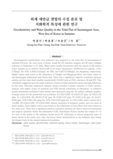

-
 * 본 문서는 배포용으로 복사 및 편집이 불가합니다.
* 본 문서는 배포용으로 복사 및 편집이 불가합니다.
미리보기
서지정보
· 발행기관 : 한국습지학회
· 수록지 정보 : 한국습지학회지 / 6권 / 1호
· 저자명 : 박경수, 박승윤, 이삼근, 이윤
목차
1. 서론
2. 재료 및 방법
3. 결과 및 고찰
4. 감사의글
참고문헌초록
전북 군산 및 부안 지역을 중심으로 이루어지는 새만금간척공사 수역과 그 주변 해역의 수질 및 저질 분포 특성을구명하기 위하여 2001년 9월에 총 101개 퇴적물 시료와 69개의 해수 시료를 채취, 분석하였다. 주요 수질 항목별 평균 및 표준편차는 수온 25.51±0.68℃, 염분 29.88±5.01psu, COD 1.40±0.78 mg/L, 용존무기질소 (DIN)0.352±0.417 mg/L, 그리고 인산인 0.027±0.023 mg/L 이었다. 영양염류 및 COD는 동진강 및 만경강 하구에서매우 높은 농도를 보였으며, 곰소만과 새만금 입구 수역은 매우 낮은 값을 보였다. COD, 영양염류 농도 및 N/P 등은 염분과 유의적 역상관관계를 보였으며, 이는 대부분의 오염 물질이 육상 기원임을 시사하였다. 주성분 분석에 의한 수질 분포 역시 새만금 수역으로 유입되는 지류에서 높은 영양염류 및 유기물 농도를 보여 타 수역에 비하여 수질오염도가 높았다. 퇴적물의 경우 주요 중금속류 및 일반저질항목별 농도는 알루미늄 2.28±0.92%, 카드뮴 0.61±0.27 ppm, 구리 8.95±4.06 ppm, 철 1.19±0.37%, 망간 182.31±77.45 ppm, 니켈 10.83±4.97 ppm, 납 15.20±4.35 ppm, 아연 41.34±34.62 ppm, COD 2.68±1.85 mg/g dry, AVS 0.04±0.08 mg/g dry, 강열감량 1.29±1.08%, 함수율 24.11±4.49%, 총질소 0.02±0.02% 그리고 총탄소 0.22±0.30% 이었다. 저질의 공간 분포 특성은 수질처럼 명확하지는 않았으나, 금강하구 수역에서 전반적으로 높은 농도를 보였다. 저질 항목별 상관관계는 중금속과 유기물함량 간에 유의적 관계가 있었으며 (p<0.05), 퇴적물내의 농축비 (enrichment factor)가 대부분 수역에서 1-2의 범위를 보여 중금속의 외부 유입이 심각하지 않은 것으로 밝혀졌다. 또한 퇴적물 내의 중금속 농도 역시 일반적인 해양 퇴적물에서 검출되는 범위 이내로 새만금 및 주변 수역의 저질 상태는 매우 양호한 것으로 판단된다.
영어초록
Environmental quality(water and sediment) was analyzed in the tidal flat of Saemangum of
Jeonbuk Province, the west coast of Korea, using the 101 sediment samples and 69 water samples
collected in September 4~13, 2001. Major water quality parameters with the means of 69 surface
water samples are as follows; 25.51±0.68 ℃ for water temperature, 29.88±5.01 for salinity, 1.40±
0.78mg/L for COD, 0.352±0.417mg/L for DIN, and 0.027±0.023mg/L for phosphate, respectively.
Higher values were found at the subestuary of Dongjin and Mangyung River, and lower values at
the Saemangum embayment and Gomso Bay. There was a significant negative correlation between
salinity and the other water quality parameters(p<0.0001) such as COD, nutrients, SS and N/P. This
correlation suggested that the major pollution sources be from terrestrial inputs through tributaries
in this area. Principal component analysis clearly revealed a spatial variation of water quality;
stations with higher values of nutrients and COD located subestuary of tributaries. 14 sediment
quality parameters including 8 trace metals were measured using the 101 surface sediment samples.
Average values for the parameters are as follows; Al 2.28±0.92%, Cd 0.61±0.27 ppm, Cu 8.95±4.06
ppm, Fe 1.19±0.37%, Mn 182.31±77.45 ppm, Ni 10.83±4.97 ppm, Pb 15.20±4.35 ppm, Zn 41.34±
34.62 ppm, COD 2.68±1.85 mg/g dry, AVS 0.04±0.08 mg/g dry, IL 1.29±1.08%, water content 24.11
±4.49%, TN 0.02±0.02%, TC 0.22±0.30%. Spatial variations of sediment quality were not clear as
water quality. Some higher values were found at the subestuary of Gum River and lower values at
the other area. There was a significant positive correlation between the heavy metal concentrations
and organic materials within the sediment(p<0.05). Enrichment factors showed the ranges of 1~2
for most of the metals in the sediment except zinc(1~6), indicating no serious exogenous input of
heavy metals in the study area. Also, the heavy metal concentrations in the sediment were within
the ranges found at the natural marine environments.참고자료
· 없음태그
-
자료후기
-
자주묻는질문의 답변을 확인해 주세요

꼭 알아주세요
-
본 학술논문은 (주)학지사와 각 학회간에 저작권계약이 체결된 것으로 AgentSoft가 제공 하고 있습니다.
본 저작물을 불법적으로 이용시는 법적인 제재가 가해질 수 있습니다. -
해피캠퍼스는 구매자와 판매자 모두가 만족하는 서비스가 되도록 노력하고 있으며, 아래의 4가지 자료환불 조건을 꼭 확인해주시기 바랍니다.
파일오류 중복자료 저작권 없음 설명과 실제 내용 불일치 파일의 다운로드가 제대로 되지 않거나 파일형식에 맞는 프로그램으로 정상 작동하지 않는 경우 다른 자료와 70% 이상 내용이 일치하는 경우 (중복임을 확인할 수 있는 근거 필요함) 인터넷의 다른 사이트, 연구기관, 학교, 서적 등의 자료를 도용한 경우 자료의 설명과 실제 자료의 내용이 일치하지 않는 경우
“한국습지학회지”의 다른 논문도 확인해 보세요!
-
한국 서해 강화 갯벌의 퇴적물 특성 12 페이지
강화 남단 갯벌은 우리나라 서해안의 가장 규모가 큰 갯벌 중의 하나이다. 조석은 전형적인 반일주조로 최대조차가 약 10m 이다. 강화 남단 갯벌은 한강 수계로부터 많은 양의 퇴적물이 유입된다. 연구지역에서 2003년 8월에 83개 정점에서 표층퇴적물을 채취하여 분석하였다. 표층퇴적물은 5개의 퇴적상으로 구성 되어 있었다. 일반적으로 모래 펄 퇴적물은 강화 .. -
한강 하구역의 염분 분포 및 생태환경특성 18 페이지
한강 하구의 염분 및 생태 환경에 관한 연구를 위하여 기존에 발표된 논문과 국립수산과학원의 국가해양환경측정망자료를 이용하여 한강 하구의 염분 분포 특성을 구명하였으며, 염분과 연관하여 동식물플랑크톤, 저서생물 및 어류플랑크톤의 분포를 논의하였다. 염분의 시공간적 분포를 고려할 때 인천북항 주변 해역은 계절에 무관하게 연중 한강 유입수의 직접적인 영향을 받고.. -
하계 강화도 갯벌의 혐기성 유기물 분해능 및 황산염 환원력 16 페이지
갯벌이나 연안습지의 생태구조 및 생지화학적 물질 순환을 이해하기 위해서는 유기물 분해기능 평가 및 분해경로에 대한 연구가 필수적으로 진행되어야 함에도 불구하고 국내에는 이에 대한 연구가 거의 없다. 본 논문에서는 하계 강화도 남단의 갯벌에서 미생물에 의한 혐기성 유기물 분해정도를 파악하고, 황산염 환원을 통한 유기물 분해경로의 정량적 중요성을 평가하고자 하.. -
조류에 의한 갯벌의 등급화 연구 11 페이지
본 연구는 조류에 의한 갯벌 등급화 기준을 설정하여 갯벌을 평가하였다. 갯벌의 등급은 절대 등급화와 상대 등급화의 두 가지 방법이 시도되었다. 첫째, 절대 등급화는 개체수, 보호종, 보호종의 개체수, 생존 집단의 1%기준을초과하는 종수, 국내 도래 집단의 1%기준을 초과하는 종수 등 5가지 기준 요인을 설정하였다. 이후 5개 기준의 합계 점수에 의해 갯벌 .. -
우리나라 갯벌의 경제적 가치 16 페이지
새만금 간척사업을 둘러싸고“개발이냐 보전이냐”에 관한 사회적 논의 이후 1998년 습지보전법을 제정한 바 있다. 그 후 갯벌의 경제적 가치에 대한 논의는 활발하지만 아직까지 우리사회는 갯벌의 일반적 가치를 제시할 만한연구의 폭과 깊이를 확보하지 못한 상태이다. 이러한 한계를 고려하면서, 본 연구에서는 압막 - 상태 - 영향 - 반응(P - S - I - R..
찾으시던 자료가 아닌가요?
지금 보는 자료와 연관되어 있어요!
문서 초안을 생성해주는 EasyAI



